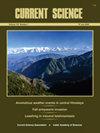Subsoiling and crop rotation improve root growth of Bt-cotton in Vertisols
IF 1.1
4区 综合性期刊
Q3 MULTIDISCIPLINARY SCIENCES
引用次数: 0
Abstract
Soil compaction is a major physical constraint in cotton production. At present, no information is available on the effects of compaction on the root growth and root anatomy of cotton ( Gossypium hirsutum L.). Therefore, we studied the effects of subsoiling (shallow (SSS) and deep (DSS)) and crop rotation (pigeon pea ( Cajanus cajan ) – cotton (PCR) and radish ( Raphanus sativus ) – cotton (RCR)) on the root growth of cotton in deep Vertisols during 2017–19. Subsoiling significantly increased the shoot and root length. The root-to-shoot ratio was maximum in DSS (33%), followed by PCR (29%) at the vegetative stage. Scanning electron microscopy analysis of the roots indicated a large number of pores and less contraction of xylem and phloem in the sub-soiled and rotation treatments than in the control. Furthermore, the SEM-EDAX spectra indicated a greater abundance of major, secondary and micronutrients in subsoiling and crop rotations compared to the control treatment.深耕和轮作促进了旱地bt棉的根系生长
土壤压实是制约棉花生产的主要物理因素。目前,压实对棉花根系生长和根系解剖结构的影响尚不清楚。因此,我们研究了2017 - 2019年深耕(浅耕(SSS)和深耕(DSS))和作物轮作(木豆(Cajanus cajan) -棉(PCR)和萝卜(Raphanus sativus) -棉(RCR))对深耕土壤棉花根系生长的影响。深耕显著增加了茎长和根长。DSS处理的根冠比最高(33%),PCR处理次之(29%)。根的扫描电镜分析表明,与对照相比,土下处理和轮作处理的木质部和韧皮部气孔较多,收缩较少。此外,SEM-EDAX光谱显示,与对照处理相比,深埋和轮作处理的主要、次要和微量营养元素丰度更高。
本文章由计算机程序翻译,如有差异,请以英文原文为准。
求助全文
约1分钟内获得全文
求助全文
来源期刊

Current Science
综合性期刊-综合性期刊
CiteScore
1.50
自引率
10.00%
发文量
97
审稿时长
3 months
期刊介绍:
Current Science, published every fortnight by the Association, in collaboration with the Indian Academy of Sciences, is the leading interdisciplinary science journal from India. It was started in 1932 by the then stalwarts of Indian science such as CV Raman, Birbal Sahni, Meghnad Saha, Martin Foster and S.S. Bhatnagar. In 2011, the journal completed one hundred volumes. The journal is intended as a medium for communication and discussion of important issues that concern science and scientific activities. Besides full length research articles and shorter research communications, the journal publishes review articles, scientific correspondence and commentaries, news and views, comments on recently published research papers, opinions on scientific activity, articles on universities, Indian laboratories and institutions, interviews with scientists, personal information, book reviews, etc. It is also a forum to discuss issues and problems faced by science and scientists and an effective medium of interaction among scientists in the country and abroad. Current Science is read by a large community of scientists and the circulation has been continuously going up.
Current Science publishes special sections on diverse and topical themes of interest and this has served as a platform for the scientific fraternity to get their work acknowledged and highlighted. Some of the special sections that have been well received in the recent past include remote sensing, waves and symmetry, seismology in India, nanomaterials, AIDS, Alzheimer''s disease, molecular biology of ageing, cancer, cardiovascular diseases, Indian monsoon, water, transport, and mountain weather forecasting in India, to name a few. Contributions to these special issues ‘which receive widespread attention’ are from leading scientists in India and abroad.
 求助内容:
求助内容: 应助结果提醒方式:
应助结果提醒方式:


